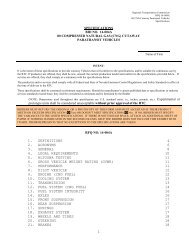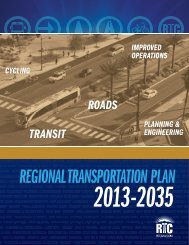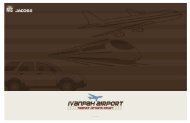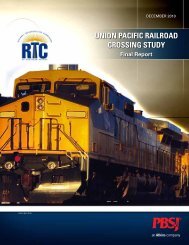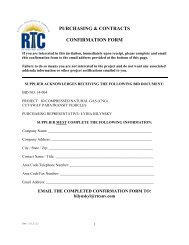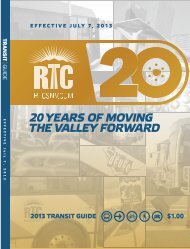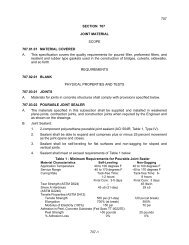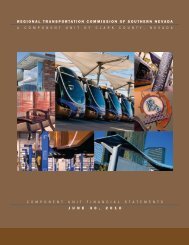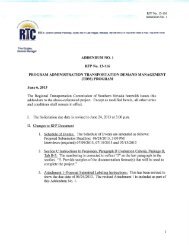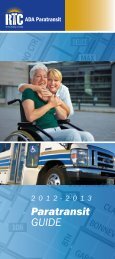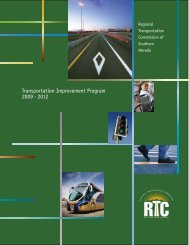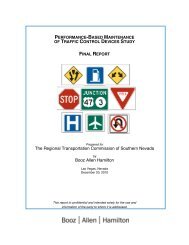(Blue Diamond Road) Corridor Study - Regional Transportation ...
(Blue Diamond Road) Corridor Study - Regional Transportation ...
(Blue Diamond Road) Corridor Study - Regional Transportation ...
You also want an ePaper? Increase the reach of your titles
YUMPU automatically turns print PDFs into web optimized ePapers that Google loves.
8. Estimated System Costs RTC SR-160 <strong>Corridor</strong> <strong>Study</strong><br />
8.0 COST ESTIMATES FOR TRANSIT ALTERNATIVES<br />
This section provides capital and operating cost estimates for each of the transit alternatives<br />
under consideration for the SR-160 corridor. For each of the alternatives – Alternative 1<br />
high build and Alternative 2 low build – costs are provided for three time horizons: 1) 2008,<br />
2) 2015, and 3) 2025, for a total of six transit alternatives. Capital estimates are provided<br />
first for each of the six alternatives, followed by annual operating costs for each alternative.<br />
8.1 CAPITAL COST ESTIMATES<br />
8.1.1 Overview of Capital Cost Benchmarks<br />
Capital costs are an important component<br />
in assessing the suitability of a given<br />
modal technology to the ridership<br />
characteristics of a given corridor.<br />
Conventional Bus Transit<br />
Standard 40-ft bus currently in use on CAT service<br />
Conventional fixed route bus service is a<br />
low-cost system that operates on mixed<br />
traffic streets, roads and highway without<br />
any special running way requirements.<br />
The basic requirement for fixed route bus service is a roadway and locations to stop and<br />
service passengers. Bus stops often include information indicating the carrier, the location<br />
of the bus stop, route alignment and the schedule. Typically, stops served by conventional<br />
fixed route bus lines with high ridership are provided with a protective shelter with seating<br />
and more transit information. Where no roadway investment is required, the only additional<br />
cost that may be incurred is the purchase of new transit vehicles where spare vehicles are<br />
not available. Conventional bus service could be provided on the corridor at minimal cost<br />
Bus stops can be located where desired along SR-160 by the placement of simple signs and<br />
benches, and buses can be purchased or redeployed to support the service. This could be<br />
an appropriate “first step” prior to providing a more elegant transit solution.<br />
Bus Rapid Transit (BRT)<br />
RTC has already implemented one bus rapid transit line in the Las Vegas Region. CAT<br />
operates RTC Southern Nevada’s Metropolitan Area Express (MAX) route, which travels<br />
northeast from the Downtown <strong>Transportation</strong> Center (DTC) to North Las Vegas along North<br />
Las Vegas Boulevard. The MAX system includes a curbside lane reserved for operation of<br />
transit vehicles and turning vehicles. Stations are generally spaced between 0.75 and 1.0<br />
miles apart. Station architecture includes a canopy for weather and sun protection, map<br />
cases, fare vending machines, vending machines for beverages, and seating. MAX<br />
8-1



